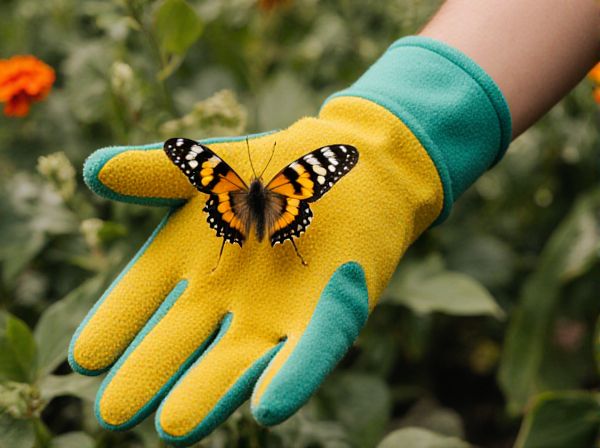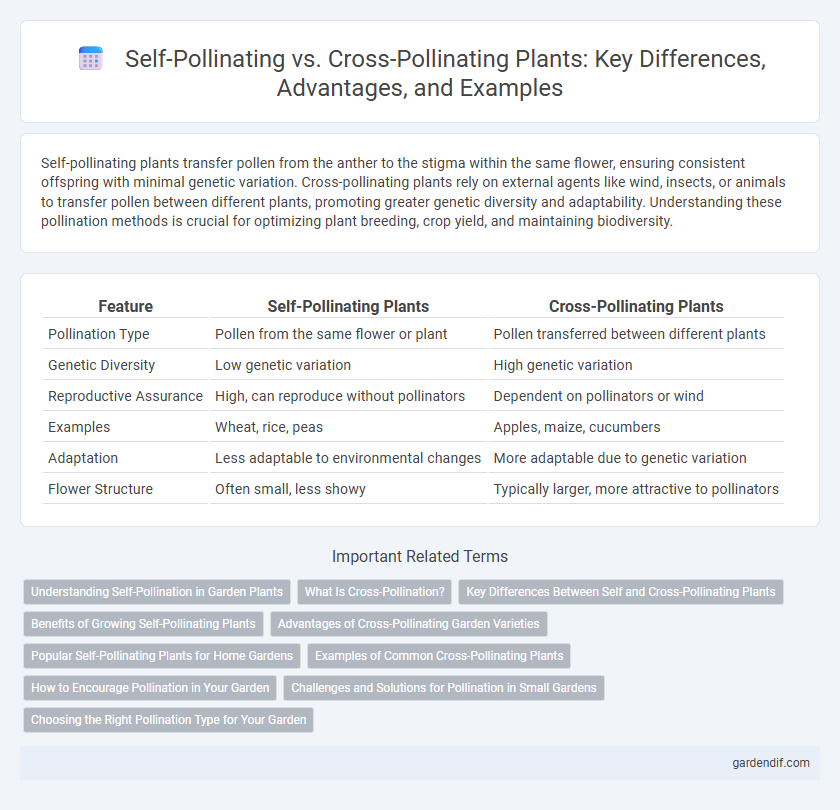
Self-Pollinating vs Cross-Pollinating Illustration
Self-pollinating plants transfer pollen from the anther to the stigma within the same flower, ensuring consistent offspring with minimal genetic variation. Cross-pollinating plants rely on external agents like wind, insects, or animals to transfer pollen between different plants, promoting greater genetic diversity and adaptability. Understanding these pollination methods is crucial for optimizing plant breeding, crop yield, and maintaining biodiversity.
Table of Comparison
| Feature | Self-Pollinating Plants | Cross-Pollinating Plants |
|---|---|---|
| Pollination Type | Pollen from the same flower or plant | Pollen transferred between different plants |
| Genetic Diversity | Low genetic variation | High genetic variation |
| Reproductive Assurance | High, can reproduce without pollinators | Dependent on pollinators or wind |
| Examples | Wheat, rice, peas | Apples, maize, cucumbers |
| Adaptation | Less adaptable to environmental changes | More adaptable due to genetic variation |
| Flower Structure | Often small, less showy | Typically larger, more attractive to pollinators |
Understanding Self-Pollination in Garden Plants
Self-pollinating garden plants, such as tomatoes and peas, transfer pollen within the same flower or between flowers on the same plant, ensuring consistent fruit production without needing external pollinators. This genetic stability promotes uniformity in traits like flower color and fruit size, ideal for gardeners seeking predictable results. While cross-pollination can increase genetic diversity, self-pollination offers reliability in controlled environments or limited pollinator presence.
What Is Cross-Pollination?
Cross-pollination occurs when pollen from the anther of one plant fertilizes the stigma of a different plant, promoting genetic diversity and stronger offspring. This process is essential for many fruit, vegetable, and flowering plants to enhance disease resistance and adaptability. Insects, wind, and animals often act as natural pollinators to facilitate cross-pollination between plants of the same species.
Key Differences Between Self and Cross-Pollinating Plants
Self-pollinating plants transfer pollen from the anther to the stigma of the same flower or another flower on the same plant, ensuring genetic consistency and stable traits across generations. Cross-pollinating plants rely on external agents like wind, insects, or animals to move pollen between different plants, promoting genetic diversity and adaptability. The key difference lies in genetic variation, where self-pollination limits diversity while cross-pollination enhances it, influencing plant breeding and crop resilience strategies.
Benefits of Growing Self-Pollinating Plants
Self-pollinating plants ensure consistent fruit production as they do not rely on external pollinators, making them ideal for controlled environments or regions with limited insect activity. These plants often exhibit greater genetic uniformity, which can lead to predictable crop traits and uniform harvests. Growing self-pollinating varieties reduces dependency on weather conditions and pollinator populations, enhancing crop reliability and stability.
Advantages of Cross-Pollinating Garden Varieties
Cross-pollinating garden varieties promote greater genetic diversity, leading to improved plant resilience against pests, diseases, and environmental stresses. These varieties often exhibit enhanced vigor and higher yields compared to self-pollinating counterparts. The increased genetic variation also supports the development of new traits, increasing adaptability and long-term sustainability of garden ecosystems.
Popular Self-Pollinating Plants for Home Gardens
Popular self-pollinating plants for home gardens include tomatoes, peppers, and peas, which do not rely on external pollinators to produce fruit. These plants ensure reliable yields in confined spaces or areas with limited insect activity, making them ideal for urban gardening. Their ability to independently fertilize flowers reduces seed variability, providing gardeners with consistent crop quality.
Examples of Common Cross-Pollinating Plants
Common cross-pollinating plants include apple trees, which rely on bees to transfer pollen between different trees for fruit production. Corn is another example, where wind facilitates pollen movement from tassels to silks of separate plants. Squash plants depend on insects like bees for effective cross-pollination, ensuring genetic diversity and improved yield.
How to Encourage Pollination in Your Garden
To encourage pollination in your garden, plant a diverse array of flowering species that bloom at different times to provide consistent nectar and pollen sources for pollinators. Incorporate native plants to attract local bees, butterflies, and other pollinators crucial for cross-pollinating species, while also ensuring sufficient self-pollinating plants for reliable fruit production. Create habitat features like water sources, shelter, and avoid pesticides to support healthy pollinator populations and enhance overall garden pollination success.
Challenges and Solutions for Pollination in Small Gardens
Self-pollinating plants face fewer challenges in small gardens as they do not require external pollen transfer, ensuring more reliable fruit set even with limited pollinator presence. Cross-pollinating plants often struggle in confined spaces due to reduced pollinator activity and limited neighboring plants, which can lead to poor pollination and lower yields. Strategies such as planting pollinator-attracting flowers, hand pollination, and increasing plant density can significantly enhance cross-pollination success in small garden environments.
Choosing the Right Pollination Type for Your Garden
Self-pollinating plants, such as tomatoes and peas, offer the advantage of reliable fruit set without the need for nearby pollinators, making them ideal for small or isolated gardens. Cross-pollinating plants, including apples and cucumbers, require pollen from different individuals to produce fruit, promoting genetic diversity and often resulting in higher yields and disease resistance. Selecting the right pollination type depends on garden size, desired genetic variation, and availability of pollinators to optimize plant health and productivity.
Self-Pollinating vs Cross-Pollinating Infographic

 gardendif.com
gardendif.com